

The Rise of the Weaponized AI Propaganda Machine - Scout: Science Fiction + Journalism - Medium. By Berit Anderson and Brett Horvath This piece was originally published at Scout.ai.
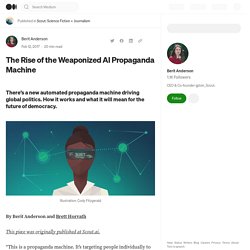
“This is a propaganda machine. It’s targeting people individually to recruit them to an idea. It’s a level of social engineering that I’ve never seen before. They’re capturing people and then keeping them on an emotional leash and never letting them go,” said professor Jonathan Albright. Albright, an assistant professor and data scientist at Elon University, started digging into fake news sites after Donald Trump was elected president. By leveraging automated emotional manipulation alongside swarms of bots, Facebook dark posts, A/B testing, and fake news networks, a company called Cambridge Analytica has activated an invisible machine that preys on the personalities of individual voters to create large shifts in public opinion.
Most recently, Analytica helped elect U.S. The company is owned and controlled by conservative and alt-right interests that are also deeply entwined in the Trump administration. How Netflix’s ‘The Great Hack’ Misses the Point. For a moment, it looked as though capitalism was doing precisely what it is supposed to do, policing itself through the market.
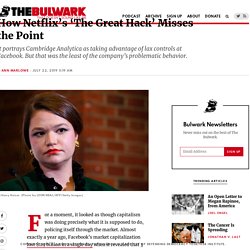
Almost exactly a year ago, Facebook’s market capitalization lost $119 billion in a single day when it revealed that 3 million Europeans had closed their accounts and that growth projections had slowed in the wake of the Cambridge Analytica data scandal. The scandal erupted when British journalist Carole Cadwalladr orchestrated revelations by Cambridge Analytice whistleblower data scientist Christopher Wylie to the New York Times and Guardian, together with a sting operation by the U.K.’s Channel 4 News. Wylie admitted to working with a Cambridge University professor, Alexsandr Kogan, on for-profit use of data from FB profiles that was collected under the premise that it was for academic research. There has been much back-and-forth about when —and if—Cambridge Analytica deleted the data. As a result, the EU introduced new data protection laws.
Así funcionaba la recolección de datos de Cambridge Analytica – Español. This is how Cambridge Analytica’s Facebook targeting model really worked — according to the person who built it. The researcher whose work is at the center of the Facebook–Cambridge Analytica data analysis and political advertising uproar has revealed that his method worked much like the one Netflix uses to recommend movies.
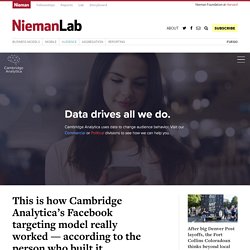
In an email to me, Cambridge University scholar Aleksandr Kogan explained how his statistical model processed Facebook data for Cambridge Analytica. The accuracy he claims suggests it works about as well as established voter-targeting methods based on demographics like race, age, and gender. If confirmed, Kogan’s account would mean the digital modeling Cambridge Analytica used was hardly the virtual crystal ball a few have claimed. Yet the numbers Kogan provides also show what is — and isn’t — actually possible by combining personal data with machine learning for political ends. Regarding one key public concern, though, Kogan’s numbers suggest that information on users’ personalities or “psychographics” was just a modest part of how the model targeted citizens.
Cómo utilizó Cambridge Analytica los datos de Facebook para manipular a los votantes. Cambridge Analytica se encuentra en el centro de un ciclón mediático que, a medida que pasan los días, se extiende por todo el mundo y pone el foco sobre la protección (o desprotección) de los datos privados de los usuarios de Facebook.
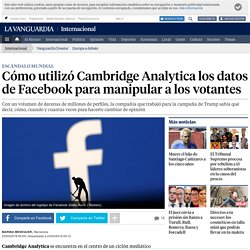
La compañía de marketing político con sede en Londres ha sido acusada de haber usado datos obtenidos indebidamente de al menos 50 millones de perfiles de la red social para estudiar su comportamiento y personalidad y, así, lanzarles mensajes que pudieran alterar su intención de voto. Así son los sofisticados métodos que usó Cambridge Analytica para influenciar elecciones en todo el mundo (también en América Latina) How Thomas Cook made the jump from travel brand to media owner. British holiday giant Thomas Cook, has gone through some turbulent moments in the last few years, enduring a changing holiday marketplace as well as recent political upheaval and terrorist incidents in tourist destinations; such as the attacks in Sousse, Tunisia.
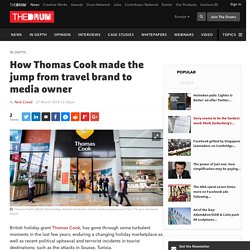
Against this backdrop, the FTSE 250 company has spend the past seven years focused on gleaning value from data it holds on the 22 million customers it has interactions with each month. In 2015 it enlisted Stuart Adamson to launch Thomas Cook Media Partnerships as managing director, with the exec previously having served as group head of media partnerships, and previously head of media solutions. Adamson, speaking this week at the FIPP Innovators Summit in Berlin said when the division launched the brand was a “media owner waiting to happen” and that his team has since built the division into a media powerhouse. The next move was to begin incorporating these digital insights in the offline world.
Additional reporting by Sam Bradley. Los planes de Facebook tras el escándalo de robo de datos – Español. “El ‘Brexit’ no habría sucedido sin Cambridge Analytica” Pregunta.

¿Cuál ha sido su motivación para hablar? Respuesta. Mi intención original era exponer el trabajo de Cambridge Analytica, en parte porque yo ayudé a montarla y tengo una responsabilidad. Si no para corregir lo que ya se ha hecho, pues hay cosas que no pueden deshacerse, al menos para informar a las autoridades y a la gente. P. R. P. R. P. R. P.